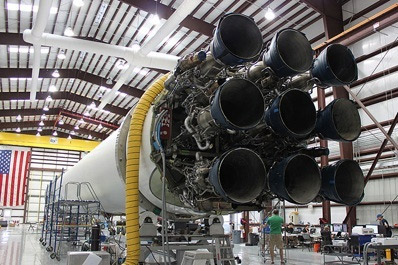

Falcon 9 rocket’s engines. Although 1 engine failed during the launc on October 7, the Dragon cargo made succesfully to the ISS (Credits: SpaceX).
NASA feels certain of SpaceX’s capacity to safely deliver another supply cargo to the International Space Station (ISS) on March 1 from Cape Canaveral, although the joint investigation into Falcon 9’s rocket engine malfunction is still open.
Mike Suffredini, NASA’s ISS program manager, reported that the rocket engines are now “good to go” during a press conference on ISS status and activity on January 17.
On October 7, 2012, SpaceX launched the first commercial mission to the ISS. A Falcon 9 rocket lifted off from Cape Canaveral with a cargo module to be attached to the station. After 79 seconds, one of the nine Merlin 1C engines powering the 1st stage suddenly shut down. The remaining motors were able to compensate, delivering the Dragon spacecraft to ISS; however a small Orbcomm satellite failed to be inserted in its correct orbit as a result of the shutdown. SpaceX stated that although the engine shut down, the sensors kept on recording data. These data were reviewed but engineers were not able to identify the cause of failure, mostly because the system was lost in the ocean.
Investigators now think that additional testing on the engines may have contributed to a pressure chamber breach resulting in the motor’s failure. The engines prepared for the next flight have been carefully inspected, however, none has been tested beyond the required levels for the flight certification.
Meanwhile, SpaceX announced a pad abort test at the company’s launch complex at Cape Canaveral in December. The full scale test is meant to demonstrate how passengers aboard the Dragon capsule on the top of a Falcon rocket at zero altitude and airspeed could safely fly away from a malfunctioning Falcon rocket. During the test, a Dragon capsule will ignite its thrusters to get away from the launch pad as quickly as possible and after flying towards the Atlantic Ocean, parachute into the water. A second test will be carried out in April 2014, when a Dragon capsule will have to demonstrate its ability to get away from a Falcon 9 rocket at full speed.
The tests are essential for SpaceX to launch its first crewed Dragon mission to ISS in 2015.
Below, the Falcon 9 launch on October 7 (Courtesy of WSJ):
[youtube http://www.youtube.com/watch?v=_18hsqaDrHs]

















































































































![A trajectory analysis that used a computational fluid dynamics approach to determine the likely position and velocity histories of the foam (Credits: NASA Ref [1] p61).](http://www.spacesafetymagazine.com/wp-content/uploads/2014/05/fluid-dynamics-trajectory-analysis-50x50.jpg)



Leave a Reply